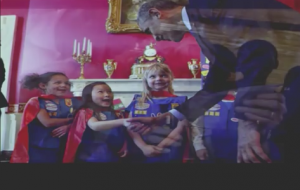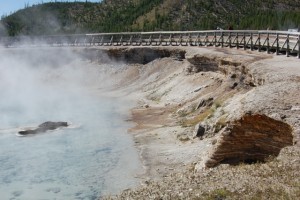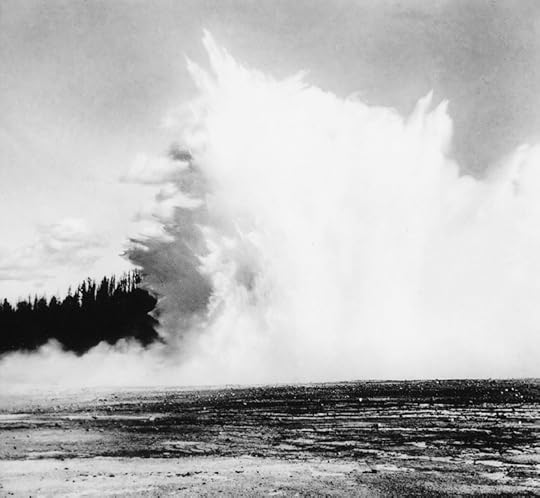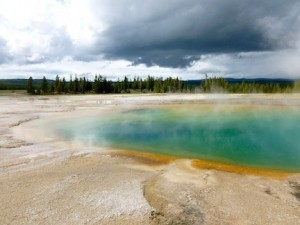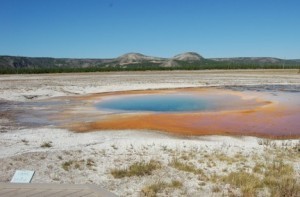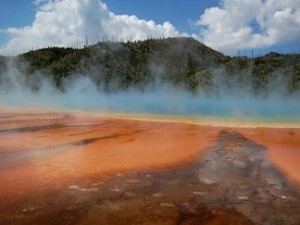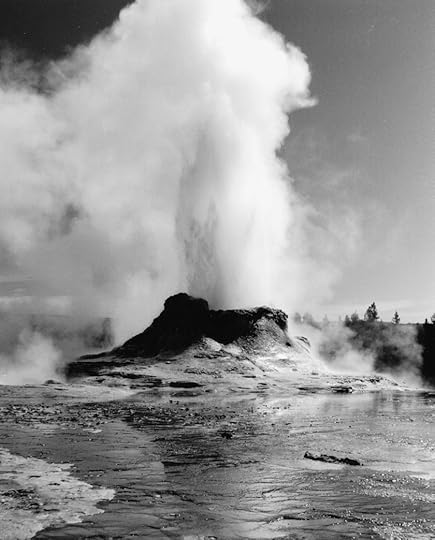Janet Chapple's Blog, page 16
April 4, 2015
Science for Parks conference, part 4
4. Sally Jewell and the Horace Albright Lecture in Conservation
Presented as a part of the Science for Parks conference, UC–Berkeley’s annual Horace Albright Lecture in Conservation, open to the public on the evening of March 26, treated us to all-too-brief introduction to Sally Jewell, U.S. Secretary of the Interior since April 2013, and four other illustrious speakers. Jewell was one of the panelists discussing “America’s Two Best Ideas—Public Education and Public Lands.”
To open the event, University of California Chancellor Nicholas Dirks gave a brief address. The panel’s moderator was Michael Krasny, a familiar voice to listeners to San Francisco’s public radio station KQED as host of the station’s morning Forum program. In addition to Jewell, the other two panelists were Janet Napolitano, formerly Secretary of Homeland Security and now president of the University of California, and history professor Douglas Brinkley of Rice University, the author or co-author of some 23 books relating to American history. The entire evening’s event was videotaped and can be accessed at: parksforscience.berkeley.edu.
Secretary Jewell was born in London, England, but her family immigrated to Seattle, where she received a mechanical engineering degree from the University of Washington. She and her engineer husband have two children. After working in petroleum engineering and then in banking for many years, she became a board member of Recreational Equipment Inc. (REI) and then its chief operating officer. She’s an outdoor enthusiast herself, having climbed Mt. Rainier several times.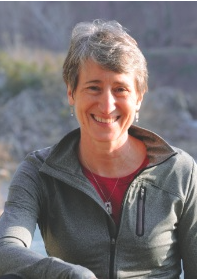
Listening to Ms. Jewell talk about her work at Interior, we can feel that the department is in very good hands. In fact, her co-panelist, historian Brinkley, pointed out that since the creation of her department in 1849, the work she has done there in less than two years compares well with that of Harold Ickes under President Roosevelt (Interior Secretary from 1933 to 1945) and of Stewart Udall (1961 to 1969) under Presidents Kennedy and Johnson.
Two initiatives taking shape under Secretary Jewell are Every Kid in a Park and the Youth Initiative. Feeling that “the best classrooms are those with no walls,” she is finding a way, beginning in fall of 2015, to give every fourth grader and his or her family a free pass to a national or state park. She intends to continue this program for twelve years. This is a beginning in an effort to change the statistics Jewell quoted: The average American schoolchild spends 56 hours per week in front of a screen and 30 minutes in the outdoors; she says they have a “nature deficit disorder.”
Already in place, another program called the Youth Initiative has begun in 50 cities with the participation of YMCAs and funding from American Express. The program was launched last year “to bridge the growing discontent between young people and the great outdoors” with goals to help children play, learn, serve, and work in outdoor spaces. Jewell cited one unit of the program’s launch, where Miami children learned to dissect small fish in nearby Biscayne National Park. This program will take place in some of the more than 75 urban national parks and other refuges and on Bureau of Land Management (BLM) recreational lands.
Secretary Jewell is also deeply concerned with the need to make parks more relevant to American minorities. “People need to see themselves and their stories in the national parks.”
Asked about the role of technology in the parks, she suggested that cell phones can (and in some places already do) give out local information in the voices of people who live nearby, and tech companies (or perhaps even REI!) could develop games involving plants, animals, or invasive species.
As she brought up the water fights in drought-stricken California, Jewell insisted that the parties must get together, stop talking over and around the subject, and solve the problems by finding common ground. “It’s hard to let go of the ‘from’ if you don’t know what the ‘to’ is,” she told us.
April 2, 2015
Science for Parks conference, part 3
3. NPS Science Advisor, Dr. Gary Machlis
The YouTube video of Gary Machlis’s talk in the final session of last week’s conference (3:10 pm, Friday) is not for the faint of heart. (For just his talk, titled “The Future of Science and the National Parks,” go to 28:24 minutes into the link provided above.)
I wrote in my notes: “This guy is brilliant”! In this instance he was talking to people, almost all of whom have a science background of some kind, but there is important and understandable take-away here for anyone willing to pay attention to what he has to say.
Gary E. Machlis has recently been appointed the first-ever science adviser to a National Park Service director. We can hope that Director Jon Jarvis will be able to take his advice to heart. Machlis is also Professor of Environmental Sustainability at Clemson University, a South Carolina public university ranked highly among science and engineering schools. And he has written and co-authored numerous books about parks, biodiversity, and related topics. His most recent is Warfare Ecology, the historical effects of violence and warfare on places such as World War I Slovenia or many parts of Africa.
Dr. Machlis provides a stellar example of how to organize a lecture of just over twenty minutes and yet plant important ideas that will take root in the minds of his audience. He begins with a mention of a 1942 book (C. C. Furnas, The Next Hundred Years), full of predictions such as that the technological limit for a wireless receiver will be a two-pound backpack. Go figure.
Machlis’s own predictions for what is “just over the horizon” in technologies that will be useful to park managers include quantum biology that will help explain how birds migrate; new ocean research platforms like the newly launched USS Neil Armstrong, designed for ocean research; “CubeSats,” tiny satellites that can gather date wherever they are; and citizen science that he foresees will involve young people up to high levels of serious participation.
Also totally new to me is the idea of “de-extinction”: cloning and re-creation of extinct species, which could involve major ethical decisions. And there was much more.
Near the end of his talk, Machlis brought out the statistic that 87% of scientists believe that human evolution took place over time, while 32% of the general public believe this. But he ended on a definitely upbeat note, showing a picture of the young girls who won awards a few days ago at the White House Science Fair.
April 1, 2015
Science for Parks conference report, part 2
2. Speaker Dr. Jane Lubchenco
Do you know how some people can stand up in front of a group and immediately grab everyone’s attention? You just know s/he will have something interesting and important to say. You sense that this is someone who spends time pondering big ideas.
This occurred last Thursday morning when Jane Lubchenco was introduced at the “Science for Parks, Parks for Science” centennial conference. Her forty-minute talk was titled, “Seas the Day! A Blue, Saltier Second Century of Interdependent Science, Parks, and People.”
Being more of a mountain person than an ocean person, I had not previously given much thought or attention to the seas—but she certainly has. Although Ms. Lubchenco was brought up and went to college closer to mountains (in Denver and Colorado Springs), she was turned on to marine biology by a summer program at Woods Hole, Massachusetts, and went on to receive a master’s degree in zoology at the University of Washington and a Harvard PhD in marine ecology.
Beginning in 1977 she and her husband, Dr. Bruce Menge, shared a unique arrangement: Oregon State University (Corvallis) allowed them to split a single position into two half-time but tenure-track positions, thus giving them both time for family duties.
Dr. Lubchenco has won numerous awards for her research and teaching, served as president of the American Association for the Advancement of Science (AAAS) and from 2009 to 2013 was chief of the National Oceanic and Atmospheric Administration (NOAA). She is still Distinguished Professor of Zoology at Oregon State. Her excellent lecture—scroll down to: Mission of the National Park Service and Its Relevancy Today (Part 2)—gives listeners a clear idea of how she has achieved so much.
Beginning by telling us that only 6% of U.S. territorial waters and less than 1% of international waters are protected, she explained that there are two types of protection but that only Marine Reserves (and not the so-called Marine Protected Areas) are truly effective. Scientists have determined that 20-30% of the oceans need this protection, yet there is little public awareness of the need. A glimmer of hope appeared last summer, when President Obama set aside the Pacific Remote Islands Marine National Monument.
Now is the time for countries to create “blue parks,” our speaker suggests, to complement the many green and brown spaces we have. Oceans are already 30% more acidic than at the beginning of the Industrial Revolution. A radical but valuable proposal is to close the high seas (all non-territorial ocean areas) to all fishing; she explained how this would actually benefit protected areas and fishermen.
Dr. Lubchenco ended her observations with a story illustrating another point she wanted to stress. While briefing Vice President Joe Biden as they flew together to view the devastation and talk to people after the 2010 Gulf Oil spill, she told him among other things how some fish and seafood can metabolize the chemicals in oil and some—such as oysters—cannot. Listening for a while, Biden said, “I thought you were a scientist.” “I am,” she said. “But I just understood everything you told me,” replied Biden. Scientists must learn to tell stories, concluded our speaker, to be “bilingual,” that is, to talk both in science-speak and in everyday language, in order to engage the public.
March 31, 2015
Science for Parks conference report
I. Insights from the Opening Ceremony
From the evening of March 25th through the 27th, I listened to and attended lectures and brief sessions at “Science for Parks, Parks for Science: the Next Century.” This event was organized on the University of California–Berkeley campus by faculty of their conservation biology and related departments, along with directors of California parks organizations, the National Park Service, the National Geographic Society, and public television station KQED.
March of 2015 marks the centennial of two major San Francisco area events. One was the Panama-Pacific International Exposition—largely sponsored by the railroads—whose Palace of Fine Arts stands in the Marina district of San Francisco to this day. You can read more about the Pan-Pacific Exposition in Alfred Runte’s excellent article, which I linked to in my March 26 blog post.
The other March 1915 event was a national park conference, convening about 75 men at Berkeley by Stephen T. Mather, then assistant secretary of the U.S. Department of the Interior. Mather was soon to become the first director of the National Park Service (in 1916). An emphasis of the conference was two “best ideas” the organizers feel are related: public education and public lands.
As a long-time aficionado of national parks, I couldn’t miss this event. The organizers will produce a book about the entire conference, but I’m sure this will take at least a year. In a few pages there is no way I can sum up all that was discussed and revealed during those intense two days and more of meetings. So I’ve decided to concentrate on a few individual speakers who impressed me greatly. In the next week or two I’ll try to give the essence of what I learned from them.
I had never before connected the National Geographic Society to the national parks. But in his remarks at the opening ceremony, Chris Johns, chief content officer for National Geographic Magazine, told us that not only was the April 1916 issue of his magazine devoted to the then-existing national parks, but that the society donated eighty thousand dollars so that the National Park Service could be set up. Thus, a new division of the Department of the Interior was born.
In the very next year (1917) three scientists investigated California’s redwoods and noted their devastation. This was the beginning of the Save the Redwoods League, which now helps to protect thirteen units of big trees in our third largest state.
National Park Service Director Jon Jarvis appeared briefly and mentioned that Gary Machlis, Professor of Environmental Sustainability at Clemson University in South Carolina, has recently been appointed to the position of first-ever science adviser to a National Park Service Director. I’ll tell you more about Machlis in a future blog post.
It seems appropriate to close this first post about the conference by listing seven serious concerns facing the national parks—and the world. They were pointed out by steering committee chairman Steve Beissinger as having occurred in the last hundred years. They are: changing climate, storms and fires of greater severity, urban encroachment and pollution, invasions of non-native species, plant and animal extinctions, changing attitudes of a public that is more urbanized, and political pressures of narrow interest groups that have sometimes led to benign neglect of parks.
You can watch the videos of the opening ceremony and all other plenary sessions at: www.parksforscience.berkeley.edu.
March 26, 2015
Science for Parks
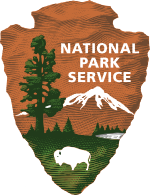 Did you know that about 100 years ago, a series of meetings held in Yellowstone, Yosemite, and the University of California at Berkeley led to the formation of the U.S. National Park Service?
Did you know that about 100 years ago, a series of meetings held in Yellowstone, Yosemite, and the University of California at Berkeley led to the formation of the U.S. National Park Service?
Here’s a belated notice about an interesting summit, “Science for Parks, Parks for Science: The Next Century,” being held in Berkeley March 25-27. The co-presenters are UC Berkeley, the National Park Service, and National Geographic Society.
Author Janet is attending and promises to share interesting tidbits she learns afterwards. The keynote speaker was E. O. Wilson. During the summit, the sessions will stream live from this page; in a few weeks all the talks will be recorded and available on YouTube.
Historian Alfred Runte wrote a thorough article about the early talks during 1911-1915, the connections with the railroads and the 1915 Panama-Pacific International Exposition, and how they led to our national parks. You can read the article, called “UC Berkeley and the National Parks: A Centennial Retrospective,” on the National Parks Traveler website.
Here’s more from the conference website:
The goal of the summit is to envision and contribute to strategies for science for parks and science using parks for the coming decades by building on the historic linkage between NPS and scientists at leading universities and other organizations around the world. This collaboration will be crucial to nurture the future health of parks and protected areas worldwide and biodiversity conservation. The summit re-dedicates that partnership in a forward-looking way by examining the mission of the National Park Service and its relevancy today, scientific and management implications of this mission in a changing world, social and cultural dimensions for advancing the mission, and the future of science for parks and parks for science.
March 24, 2015
Vote for Your Favorite National Park Lodge—and Mine
Editor Beth alerted me to a USA Today poll of their readers’ favorite lodges. Looking at the list of twenty to choose from leads me to fond memories of those eight lodges where I’ve stayed over the years. It also reminds me of about six or seven I would still love to visit. Well, I have to admit I started making a list of places I want to go, many of them national parks, when I was eleven or twelve—and I still have that little notebook.
You can easily guess what lodge I will vote for—the one I like to consider my second home, Old Faithful Inn.
Another correlation that interested me was to see whether the poll included all the sixteen lodges in Christine Barnes’s beautiful 2002 book, Great Lodges of the National Parks. Answer: No. A good many of those in the book are not in the poll, but the poll offers ten others not in the book. Those in both lists are the Old Faithful Inn, the Ahwahnee, Crater Lake Lodge, El Tovar, Bryce Canyon Lodge, Grand Canyon Lodge, Glacier Park Lodge, Many Glacier Hotel, Paradise Inn, and Yellowstone’s Lake Hotel. Ms. Barnes includes other great lodges in her second volume, published in 2012.
Just for fun, I took a personal poll of the ones I’ve stayed in so far. I came up with seven besides Old Faithful Inn. Coming in a close second to OFI would be Death Valley National Park’s Furnace Creek Inn.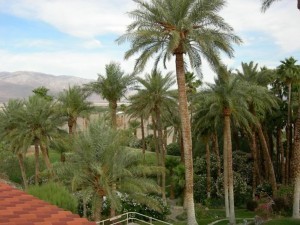
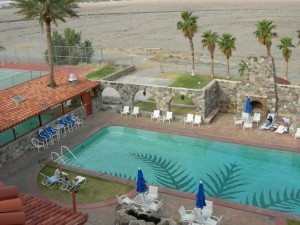
The Inn sits above an amazing oasis, a terraced garden with palm trees, a small cold stream, and a little pool with water, all from a spring in the hillside. It has a gorgeous, big swimming pool, and it’s excellent dining room and comfortable rooms are where I would rather relax than in any place else in all the months when much of Yellowstone is closed, especially March and April.
The others I’ve enjoyed are Jackson Lake and Jenny Lake Lodges in the Tetons, El Tovar in Grand Canyon National Park, the Ahwahnee in Yosemite (although this one needs a second visit from me, because it was not fully open when I was there), Wuksachi Lodge in Sequoia National Park, and what the concessionaire now calls Lake Yellowstone Hotel. I can’t happily accept that name, because its historic name is Lake Hotel (and the lake’s name is Yellowstone Lake, not Lake Yellowstone). My unsubstantiated theory is that some PR person a few years back decided lengthening the name and reversing its words had more cachet.
One other way I enjoy the lodges in my Great Lodges book is to extend my wish list. When I last visited the Grand Canyon I was too late to reserve a room in the Grand Canyon Lodge. But I was too early (before its opening on May 15th) to see the North Rim and its lodge, which isn’t on these lists. Other times I was also too late when I tried to reserve at Crater Lake Lodge and the Lodge at Bryce Canyon. In Glacier Park I’d love to stay at either Glacier Park Lodge or Many Glacier Hotel, and if I visit Mt. Rainier I’d stay in the Paradise Inn.
Place your own vote by March 30th at this USA Today website.
Photos are by Jens Paape (Old Faithful Inn, page 75 of Yellowstone Treasures) and the author.
March 17, 2015
Yellowstone Park on the Web
A United Kingdom website called “The Independent” last week passed on one misleading interpretation and one, to me, amazing coincidence.
Along with a lovely picture of Morning Glory Pool, which I wrote about last December,
their headline, “Yellowstone Park hot spring turned green by good luck coins tossed in by tourists,” seemed to imply that the metal in coins had caused the color of the pool to change. However, they clarified it in their article, explaining that a prodigious amount of tossed-in debris had caused the spring’s temperature to be lowered, allowing the colorful types of bacteria that love heat—but not too much heat—to grow far down into the pool.
The coincidence was that their photo showing the pool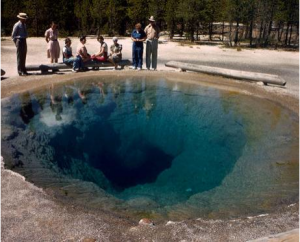
is one from the June 1940 National Geographic (but uncredited) that I discovered while researching for Yellowstone Treasures. “The Independent” admitted to retouching the image, which looks bluer and generally prettier than it does in my copy of the old magazine. But the real coincidence here is that the woman seated on the right is my mother! She was playing music during summer of 1939 in Old Faithful Inn with the other four women in the picture, who called themselves The Ladies’ Ensemble of Billings (Montana). Margaret Orvis (my mother’s name at that time) played piano with the group for tea in the afternoons. Then she took up the drums to play with them in the evening for dance music.
I doubt that Mother ever knew her picture was in the National Geographic! That was the summer I played hide-and-seek with my sister Joan in the inn.
What goes around comes around.
[Editor’s note: If you are curious, read more of Janet’s memoirs in “Janet celebrates her 75th anniversary in the Park.”]
March 14, 2015
The Half-Way Group of Yellowstone Beauties
Post three on my favorite hot springs, showcasing four more springs
It’s high time I featured the hot springs of the must-not-miss geyser basin called Midway. A short distance north of Upper Geyser Basin—where Old Faithful Geyser is located—and a similar drive from the capacious Lower Geyser Basin, is an area that was called Hell’s Half-Acre back when the park was new. Those were the days when the hot wonders of Yellowstone seemed to put travelers frequently in mind of hell and the devil.
Today’s visitors climb the boardwalk (accessible with assistance) up from the Firehole River to a remarkable caldron of steaming sky-blue water below a deep opening in the buildup of countless layers of geyserite rock deposited over the centuries.
Our pictures show a small part of Excelsior Geyser’s edge as it looks today (first photo) and an eruption in the 1880s (below), almost the only decade when this tremendous geyser is known to have erupted—as high and wide as 300 feet (90-plus meters).
Two small but lovely pools appear along the boardwalk as you leave Excelsior’s edge: well-named Turquoise Pool (first) and sometime-geyser Opal Pool (second), which is inclined to drain completely at times.
The final attraction you will pass, Grand Prismatic Spring, by itself takes up almost two acres of space, giving the lie to the old popular name for this whole basin. Not only its size but its coloring is incomparable. Yellow, orange, and brown bacterial mats encircle the central pool’s blue and green, and prodigious runoff creates gentle brown terraces leading away from the pool. On a sunny summer day, the blue of the water reflects delightfully in the pool’s steam.
Our picture was taken as we walked along the edge, but a quick look at Google Images will show you numerous shots of the whole pool taken from the air and from the hills to the west and east of the basin.
When you’ve seen Grand Prismatic Spring you will understand the dismay caused by a German tourist crashing his drone into this irreplaceable Yellowstone treasure during the summer of 2014. His careless act (and others like it) led to a total ban on drones in all national parks.
Visiting Midway Geyser Basin provides an experience like none other in the world.
The historic picture of Excelsior Geyser erupting was taken in 1888 by Frank J. Haynes (courtesy of National Park Service, Yellowstone); Excelsior’s edge, Grand Prismatic Spring, and Opal Pool (in 2010) by Bruno Giletti; and Turquoise Pool by Suzanne Cane.
March 3, 2015
One hundred thirty years ago in Yellowstone Park
Let’s celebrate March, Women’s History Month, with an excerpt from a Yellowstone story written by Margaret Andrews Allen. In 1885 her family visited Upper Geyser Basin in a horse-driven wagon. Camping near Castle Geyser, they all set out the morning after arrival to see the geysers.
“First, of course, we visit Old Faithful, the Clock of the Valley, hardly varying five minutes in its hourly eruptions. Its low, broad cone of scale-like layers is firm as the solid rock. No thought of danger here. Everything gives us the idea of regularity and order. We are in position, the curtain rises, and the play begins. The eruption is fine, the geyser sending up a solid column of water, with clouds of hot steam, for over a hundred feet. But it is soon over, and we add to our experience by drinking of the hot sulphur water it has left in all the little hollows of the crust. This is merely to add to our experience, for the taste is far from agreeable. This geyser is the great resource of hurried tourists, from its regularity. We met many parties who had seen only this one—and that one alone is well worth seeing. But what one is sure of seldom fascinates. The freaky ones are most sought after and admired.
“We cross the rushing Firehole, and I shall leave it for the guide-book to tell the variety of craters and pools, extinct and active geysers and formations, all the way from Cauliflower to Coral. We come back to our tent already feeling like old residents, ready to initiate ignorant new-comers.
“We have seen various men pass with mysterious bags on long poles, and, on questioning one of our neighbors (a very old resident, for she has been here a month) we find it is merely the family washing. The bag contains soap and clothes, and is to be hung in a boiling spring, when, in a few hours, the dirt will be boiled out. We follow suit, and immediately our bag of clothes is hanging in a lovely little blue pool not far from our tent.
“But we have a ham in our wagon; why should not that be cooked in the same way? The Devil’s Well [Crested Pool] is near, and soon our ham, in a strong sack fastened to a pole, is cheerfully bubbling away. In about two hours it is well done, and lasts us the rest of the journey. Our potatoes are not so successful, for our bag breaks, and down they go to whoever the owner of the well may be, for a perpetual potato-soup.
“At dinner, our neighbor, the Castle, starts an eruption, and immediately the whole valley is in turmoil, rushing hither and thither for a good view. But the geyser changes its mind, the clouds drift up, a drizzling rain begins, and we are settling down for a quiet afternoon in our tent when suddenly, with rumble and roar, the deceitful Castle shoots a column of water into the air and everything is dropped for the show.
“Our neighboring campers are already climbing the sides of the cone, about twenty feet above the road, to have a look inside, and we follow their example. Then stones are thrown in and shot out instantly. I bethink me of our dish-towels, and in they go. In another minute they are fifty feet in the air, and dashed down far on the other side; for a strong wind has risen and driven the water and steam in a great curve to the south. After three such baths they are clean. We have seen the only poetical washing-day in our lives. We wish all were like it. It is not turning the geyser to a base use: it is merely idealizing washing.”
Of course, the thousands of visitors to geyserland today do not use the pools and geysers to wash their clothes and dishes. But think how it must have lightened the load of “woman’s work” for the few days Ms. Allen was in Yellowstone. Times have changed!
Ms. Allen’s entire story will be reproduced in Granite Peak Publications’ upcoming collection, with the working title of Magnificent Playground.
Castle Geyser photo from 1996 by Leslie Kilduff, appears on page 99 of Yellowstone Treasures, Updated Fourth Edition.
February 25, 2015
Terrorists and Supervolcanoes
Generally, I prefer to steer clear of the media flurry every time there’s a large swarm of earthquakes or something else in the news that again brings up the subject of the Yellowstone supervolcano. But I can’t resist passing on this reaction to the recent news about a terrorist in Canada thinking that triggering the magma under Yellowstone would be a great idea.
At least the article about this that I just found ends with a sensible paragraph:
“Fortunately, the USGS agrees the likelihood of a Yellowstone volcano eruption is unlikely at this time. The volcano alert level is currently green, and seismographs detected only 178 earthquakes in the region, with the largest registering at a magnitude 1.9 on January 20, 2015. The USGS also calculates the odds against a Yellowstone eruption as 730,000 to one on an annual basis. As a comparison, the odds of a royal flush in poker is 1 in 649,740, so perhaps that’s not too comforting.”
For the best current information on the subject see this USGS page, or take a look at our own nugget about it.

